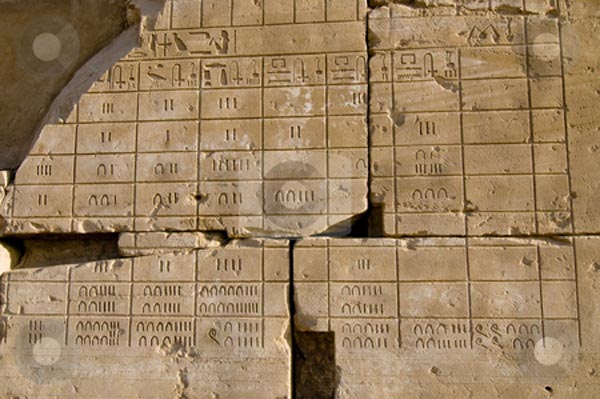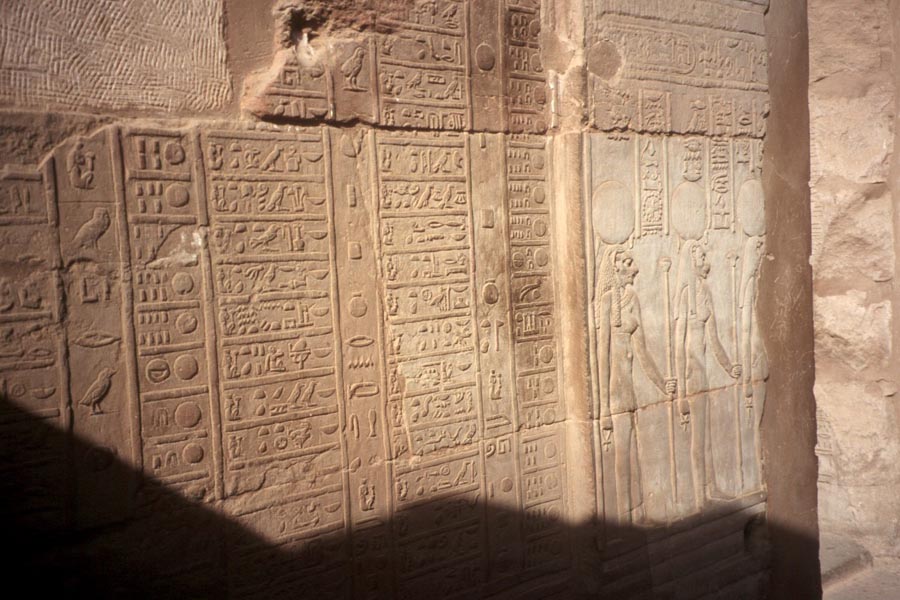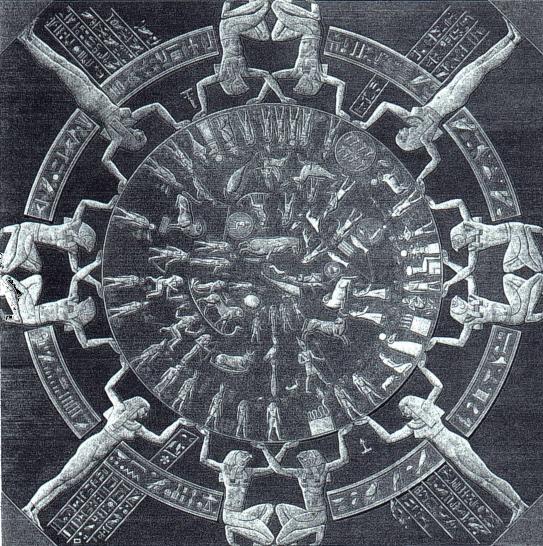



The Egyptians were probably the first to adopt a mainly solar calendar. They noted that the Dog Star, Sirius, reappeared in the eastern sky
just before sunrise after several months of invisibility. They also observed that the annual flooding of the Nile River came soon after Sirius reappeared.
They used this combination of events to fix their calendar and came to recognize a year of 365 days, made up of 12 months each 30 days long, and an extra five days added at the end. But they did not allow for the extra fourth of a day, and their calendar drifted into error. According to the famed Egyptologist J. H. Breasted, the earliest date known in the Egyptian calendar corresponds to 4236 B.C. in terms of the Gregorian calendar.
The ancient Egyptians originally employed a calendar based upon the Moon, and, like many peoples throughout the world, they regulated their lunar calendar by means of the guidance of a sidereal calendar. They used the seasonal appearance of the star Sirius (Sothis); this corresponded closely to the true solar year, being only 12 minutes shorter. Certain difficulties arose, however, because of the inherent incompatibility of lunar and solar years.
To solve this problem the Egyptians invented a schematized civil year of 365 days divided into three seasons, each of which consisted of four months of 30 days each. To complete the year, five intercalary days were added at its end, so that the 12 months were equal to 360 days plus five extra days.
This civil calendar was derived from the lunar calendar (using months) and the agricultural, or Nile, fluctuations (using seasons); it was, however, no longer directly connected to either and thus was not controlled by them. The civil calendar served government and administration, while the lunar calendar continued to regulate religious affairs and everyday life.
In time, the discrepancy between the civil calendar and the older lunar structure became obvious. Because the lunar calendar was controlled by the rising of Sirius, its months would correspond to the same season each year, while the civil calendar would move through the seasons because the civil year was about one-fourth day shorter than the solar year.
Hence, every four years it would fall behind the solar year by one day, and after 1,460 years it would again agree with the lunisolar calendar. Such a period of time is called a Sothic cycle.
Because of the discrepancy between these two calendars, the Egyptians established a second lunar calendar based upon the civil year and not, as the older one had been, upon the sighting of Sirius.
It was schematic and artificial, and its purpose was to determine religious celebrations and duties. In order to keep it in general agreement with the civil year, a month was intercalated every time the first day of the lunar year came before the first day of the civil year; later, a 25-year cycle of intercalation was introduced.
The original lunar calendar, however, was not abandoned but was retained primarily for agriculture because of its agreement with the seasons. Thus, the ancient Egyptians operated with three calendars, each for a different purpose.
The only unit of time that was larger than a year was the reign of a king. The usual custom of dating by reign was: "year 1, 2, 3 . . . , etc., of King So-and-So," and with each new king the counting reverted back to year One. King lists recorded consecutive rulers and the total years of their respective reigns.
The civil year was divided into three seasons, commonly translated: Inundation, when the Nile overflowed the agricultural land; Going Forth, the time of planting when the Nile returned to its bed; and Deficiency, the time of low water and harvest.
The months of the civil calendar were numbered according to their respective seasons and were not listed by any particular name--e.g., third month of Inundation--but for religious purposes the months had names. How early these names were employed in the later lunar calendar is obscure.
The days in the civil calendar were also indicated by number and listed according to their respective months. Thus a full civil date would be: "Regnal year 1, fourth month of Inundation, day 5, under the majesty of King So-and-So." In the lunar calendar, however, each day had a specific name, and from some of these names it can be seen that the four quarters or chief phases of the Moon were recognized, although the Egyptians did not use these quarters to divide the month into smaller segments, such as weeks.
Unlike most people who used a lunar calendar, the Egyptians began their day with sunrise instead of sunset because they began their month, and consequently their day, by the disappearance of the old Moon just before dawn.
As was customary in early civilizations, the hours were unequal, daylight being divided into 12 parts, and the night likewise; the duration of these parts varied with the seasons. Both water clocks and sundials were constructed with notations to indicate the hours for the different months and seasons of the year. The standard hour of constant length was never employed in ancient Egypt.
The ancient civil Egyptian Calendar, known as the Annus Vagus or Wandering Year, had a year that was 365 days long, consisting of 12 months of 30 days each, plus 5 extra days at the end of the year. The months were divided into 3 "weeks" of ten days each.
This calendar was in use by 2400 BCE, and possibly before that. It was used throughout antiquity. It was used by astronomers in the Middle Ages because of its mathematical regularity.
The Egyptian calendar was simple, but it is neither a lunar nor a solar calendar. Months do not correspond to lunar months, and years do not correspond to solar years. The Egyptians were aware of this, and calculated their seasonal year by the stars, to be the time between successive heliacal risings of the star Sirius (which the Egyptians called Sothis).
The heliacal rising of Sothis returned to the same point in the calendar every 1460 years (a period called the Sothic cycle). The difference between a seasonal year and a civil year was therefore 365 days in 1460 years, or 1 day in 4 years. Similarly, the Egyptians were aware that 309 lunations nearly equalled 9125 days, or 25 Egyptian years, which was likely used in the construction of a secondary lunar calendar.
According to the Roman writer Censorinus, the Egyptian New Year's Day fell on July 20 on the Julian Calendar in 139 CE, which was a heliacal rising of Sirius in Egypt. From this it is possible to calculate that the previous occasion on which this occurred was 1322 BCE, and the one before that was 2782 BCE. This latter date has been postulated as the time when the calendar was invented, though earlier historians tended to push it back another whole cycle, to 4242 BCE.
In 238 BCE, the Ptolemaic rulers decreed that every 4th year should be 366 days long rather than 365.
That practice was not followed, however, until the introduction of the "Alexandrian Calendar" in 22 BCE by Augustus.
Calendars in use today - the Coptic Calendar and the Ethiopian Calendar - are similar, as was the French Revolutionary calendar.
British orrery maker John Gleave represented the Egyptian calendar in a reconstruction of the Antikythera Mechanism, an ancient mechanical analog computer (as opposed to digital computer) designed to calculate astronomical positions. It was discovered in the Antikythera wreck off the Greek island of Antikythera, between Kythera and Crete, and has been dated to about 80 BC.
For most of Egyptian history, the months were not given individual names but rather were numbered within the three seasons of Akhet (Inundation), Proyet (Emergence), and Shomu (Harvest).
During the New Kingdom, however, each month was given its own name. These eventually evolved into the Hellenistic names that are still used today by the Coptic Church. The convention amongst modern Egyptologists is to number the months consecutively using Roman numerals.

The sculptured Dendera zodiac (or Denderah zodiac) is a widely known Egyptian bas-relief from the ceiling of the pronaos (or portico) of a chapel dedicated to Osiris in the Hathor temple at Dendera, containing images of Taurus (the bull) and the Libra (the scales). This chapel was begun in the late Ptolemaic period; its pronaos was added by the emperor Tiberius. This led Jean-Fran¨ois Champollion to date the relief correctly to the Greco-Roman period, but most of his contemporaries believed it to be of the New Kingdom.
The currently accepted date for the relief is 50 BC, since it shows the stars and planets in the positions they would have been seen at that date. The relief, which John H. Rogers characterized as "the only complete map that we have of an ancient sky" has been conjectured to represent the basis on which later astronomy systems were based. It is now on display at the Musee du Louvre, Paris.
The zodiac is a planisphere or map of the stars on a plane projection, showing the 12 constellations of the zodiacal band forming 36 decans of ten days each, and the planets. These decans are groups of first-magnitude stars. These were used in the ancient Egyptian calendar, which was based on lunar cycles of around 30 days and on the heliacal rising of the star Sothis (Sirius).
Its representation of the zodiac in circular form is unique in ancient Egyptian art. More typical are the rectangular zodiacs which decorate the same temple's pronaos.
The celestial arch is represented by a disc held up by four pillars of the sky in the form of women, between which are inserted falcon-headed spirits. On the first ring, 36 spirits symbolize the 360 days of the Egyptian year.
On an inner circle, one finds constellations, showing the signs of the zodiac. Some of these are represented in the same Greco-Roman iconographic forms as their familiar counterparts (e.g. the Ram, Taurus, Scorpio, and Capricorn, albeit most in odd orientations in comparison to the conventions of ancient Greece and later Arabic-Western developments), whilst others are shown in a more Egyptian form: Aquarius is represented as the flood god Hapy, holding two vases which gush water. Rogers noted the similarities of unfamiliar iconology with the three surviving tablets of a "Seleucid zodiac" and both relating to kudurru, "boundary-stone" representations: in short, Rogers sees the Dendera zodiac as "a complete copy of the Mesopotamian zodiac".
During the Napoleonic campaign in Egypt, Vivant Denon drew the circular zodiac, the more widely known one, and the rectangular zodiacs. In 1802, after the Napoleonic expedition, Denon published engravings of the temple ceiling in his Voyage dans la Basse et la Haute Egypte. These elicited a controversy as to the age of the zodiac representation, ranging from tens of thousands to a thousand years to a few hundred, and whether the zodiac was a planisphere or an astrological chart. Louis Charles Antoine Desaix, a member of the expedition, decided to remove the relief to France and so, in 1820, the antiquities dealer Sebastien-Louis Saulnier commissioned Jean Baptiste Leloraine, a master mason, to remove the circular zodiac with saws, jacks, and scissors constructed for the job. The zodiac ceiling was moved in 1821 to Restoration Paris and, by 1822, was installed by Louis XVIII in the Royal Library, later designated Bibliotheque nationale de France. In 1964, the zodiac moved from the Bibliotheque Nationale to the Louvre.
The controversy around the zodiac, called the "Dendera Affair", involved people of the likes of Joseph Fourier (who estimated that the age was 2500 BC), Thomas Young, Jean-Fran¨ois Champollion, and Jean-Baptiste Biot. Johann Karl Burckhardt and Jean-Baptiste Coraboeuf held, after analysis of the zodiac, that the ancient Egyptians understood the precession of the equinoxes. Champollion, among others, believed that it was a religious zodiac. Champollion deciphered the names of Tiberius, Claudius, Nero and Domitian on the ceiling of Dendera's temple, and placed the zodiac in the era of Roman rule over Egypt. Baron Georges Cuvier placed the date 123 AD to 147 AD. His discussion of the dating question is an interesting summary of the reasoning as he understood it in the 1820s.
Sylvie Cauville of the Centre for Computer-aided Egyptological Research at Utrecht University and Eric Aubourg dated it to 50 BC through an examination of the configuration it shows of the five planets known to the Egyptians, a configuration that occurs once every thousand years, and the identification of two eclipses.
Ancient Egyptian Calendar Reveals Earliest Record of 'Demon Star' Live Science - May 31, 2012
Ancient Egyptians may have chronicled the flickering of a star known as "the Demon," perhaps the earliest known record of a variable star, astronomers suggest. The ancient Egyptians wrote calendars that marked lucky and unlucky days. These predictions were based on astronomical and mythological events thought of as influential for everyday life.
The best preserved of these calendars is the Cairo Calendar, a papyrus document dating between 1163 and 1271 B.C. The entry for each day is prefaced by three hieroglyphics that indicate either good or bad luck, with the characters often derived from events of mythology. Astronomers at the University of Helsinki in Finland had previously discovered that some of the fortunate days recurred in a pattern, every 29.6 days. This almost exactly matches the length of the lunar cycle - the time between two full moons. New moons may have been associated with bad luck.
The scientists also detected another pattern in the calendar, one that occurred every 2.85 days. Now the researchers suggest this approximately matches regular dimming of Algol, "the Demon Star," which lies approximately 93 light-years away in the constellation Perseus as one of the eyes of Medusa's head. Its name comes from the Arabic phrase, ra's al-ghul, which means "the demon's head."
Algol is the brightest known example of an eclipsing binary system - the large bright member of the system, Beta Persei A, regularly gets eclipsed by the dimmer Beta Persei B. From our point of view, Algol dims by more than a factor of three for 10 hours at a time, dwindling easily seen with the naked eye. "It seems that the first observation of a variable star was made 3,000 years earlier than was previously thought," said researcher Lauri Jetsu, an astronomer at the University of Helsinki.
The Cairo Calendar describes how Wedjat, the Eye of Horus, regularly transformed from peaceful to raging, with good or bad influences on life. Horus was the patron god of kings in ancient Egypt. "The eclipse seems to be linked with the lucky days, because it represents the pacification of the Eye of Horus," researcher Sebastian Porceddu, an astronomer and Egyptologist at the University of Helsinki, told LiveScience. "A bright Eye of Horus meant it is raging and a threat to mankind."
In modern times, Algol actually dims every 2.867 days. The researchers suggest this discrepancy of 0.017 days - about 25 minutes - between ancient Egyptian and modern values for Algol's dimming may be due to changes Algol may have undergone in the past three millennia. Matter is apparently flowing from the dimmer member of this eclipsing binary to the brighter star, altering their orbit so that eclipses now take longer than they once did. If correct, this ancient Egyptian data could shed light on eclipsing binaries and the details of how such mass transfer might affect their orbits.
ANCIENT AND LOST CIVILIZATIONS INDEX